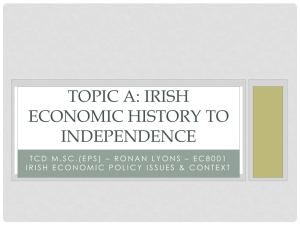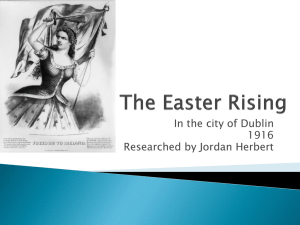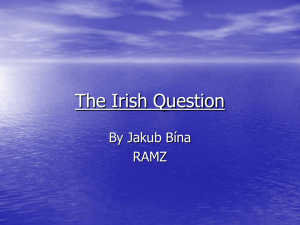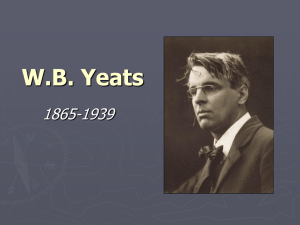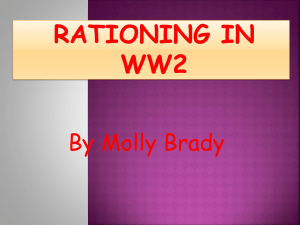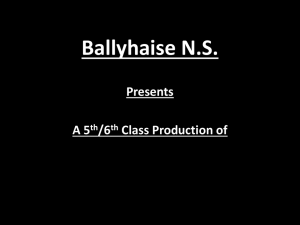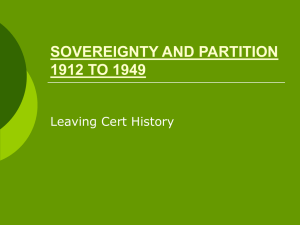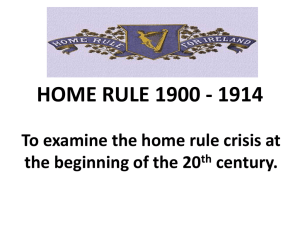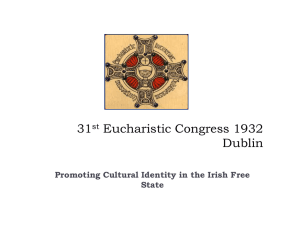Why do we celebrate St. Patrick`s Day in the USA?
advertisement
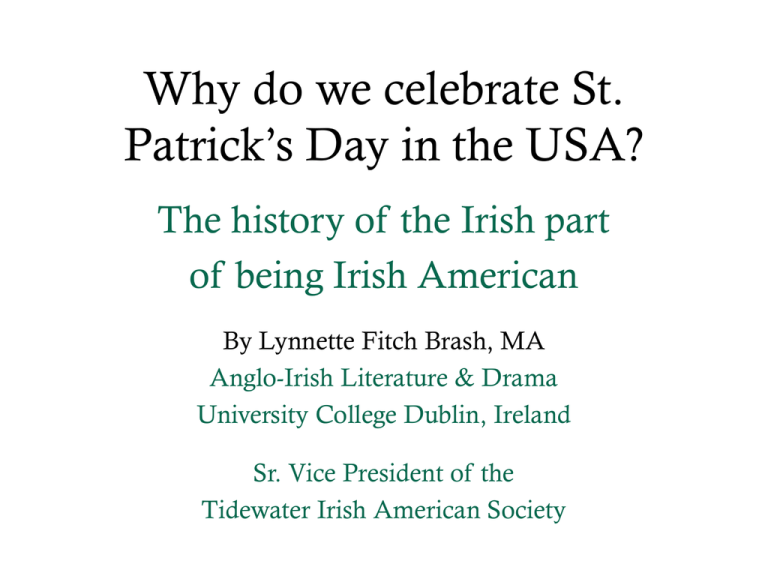
Why do we celebrate St. Patrick’s Day in the USA? The history of the Irish part of being Irish American By Lynnette Fitch Brash, MA Anglo-Irish Literature & Drama University College Dublin, Ireland Sr. Vice President of the Tidewater Irish American Society Irish Immigration to America… 1. The Ulster Scots (a.k.a. the Scots Irish) From northern province of Ireland (Ulster) – Scots who had been “planted” there in earlier centuries Came earliest – starting in the Colonial period Settled the frontiers of colonies like NY – risked death at hands of Indian raids & harsh conditions Many served & fought on the side of the Colonies in the American War of Independence – risked everything to do so Some were loyalists and fled to Canada after Brits lost the War Middle class Protestants Irish Immigration to America… 2. Irish Slave Trade Irish Catholic political prisoners were transported by the English as indentured servants AND outright slaves to be sold in the British colonies in America as well as those British colonies in the West Indies The American colonies were used as a penal colony by the English for Irish Catholic “undesirables” Irish Immigration to America… 3. Irish Catholic settlers in Catholic-friendly colonies (Maryland, New York, Pennsylvania) These 3 colonies were each – briefly – friendly toward Catholic immigrants, so Irish Catholics who could afford to come did They were trying to escape anti-Irish Catholic statutes enacted by the English Parliament back home in Ireland Unfortunately, virulently anti-Catholic English Puritans and other WASP’s in the American colonies soon enacted similar Penal Codes against Catholics in ALL of the American colonies ruled by the Brits Irish Immigration to America… 4. An Gorta Mor (The Great Hunger) Ireland was occupied by the English for 8 centuries – the English took their ancestral lands by force, gave them to English landlords, and forced the Irish to pay rent to continue to live on them Potatoes were grown for subsistence by the Irish; all other crops they grew were turned over to their landlords for rent In the late 1840’s, the potato crops were afflicted by blight, an airborne fungus carried over the Atlantic, and rotted in the fields – the Irish were left with NO food – the potato crops failed in this way for a 5 year period (1845-1850) Anyone caught hunting or fishing on the landlords’ lands was transported, usually around the world to Australia, never to return All the grain in the warehouses of Ireland was exported – none was given to the Irish for famine relief, although there was more than enough to feed them The Irish thus consider the famine genocide - and we have a LONG memory Bodies littered the roadsides, often too many for the weak survivors to bury – starving children died with green lips and tongues from trying to eat grass The Irish population was devastated and never fully recovered – 2 million died; 1 million emigrated on the “coffin ships”, starting a chain migration flood of Irish Catholics to America “NO IRISH NEED APPLY” part 1 Irish famine & post-famine immigrants faced enormous prejudice here in America People mocked their accents, dress, names, poverty, ignorance, etc. In particular, they were castigated for their religion – they were referred to as papists and their religious beliefs derided as popery – so much for religious freedom! The Know Nothing party of anti-Catholic, anti-Irish, anti-immigrant WASP nativist racists attacked Catholic communities and churches in the north, as the KKK did in the south - The Know Nothings are depicted in the film Gangs of New York “NO IRISH NEED APPLY” part 2 The stereotype of a stupid, dirty, drunken, lazy, belligerent, simian Irish race was spread – many people would refuse to hire or rent to the Irish as a result – N.I.N.A. was often posted The Irish were frequently exploited by employers who would literally work them to death, treating them worse than slaves, who at least were protected somewhat as expensive property Only the worst, hardest, dirtiest, most dangerous jobs were open to Irish men and boys – thus they went straight from arrival here to fighting in the US Civil War, working the docks, building the railroads, digging the canals, serving as hired muscle, mining underground, policing the streets, and fighting fires Irish women and girls frequently worked as house maids, took in laundry, labored in factories, or provided childcare – they were at risk of rape and seduction by the privileged class with little legal recourse – they also had no job security and were often little better than slaves “NO IRISH NEED APPLY” part 3 The Irish loved America and made their mark on it, all the while never forgetting Ireland and their history there. To show their pride in that Irish heritage, they began holding celebrations and parades on St. Patrick’s Day (March 17 - the feast day of the Catholic patron saint of Ireland) in the COLONIAL period when Irish soldiers in the British army paraded! That Irish AMERICAN tradition continued throughout the 19th and 20th century, and is alive and well in the 21st to boot! St. Patrick’s Day was nowhere near as big of a deal back in Ireland – only recently have they begun parading and having festivities to mark March 17th as a way to promote tourism The oldest and biggest St. Patrick’s Day parade is in NYC, but other American cities with HUGE celebrations on March 17th include Boston, Philadelphia, Savannah, and Chicago. Locally, we have a big parade in Ocean View, Norfolk, every year! Wearing green and shamrocks to honor Ireland are the norm – and the Irish consider EVERYONE Irish on St. Patrick’s Day, so feel free to join in!
